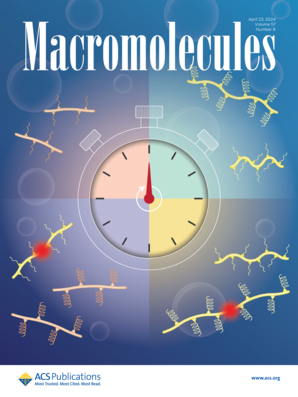Branching-Density Dependent Chain Relaxation and Orientated Crystallization Behavior of the Stretched Polylactic Acid Melt
IF 5.1
1区 化学
Q1 POLYMER SCIENCE
引用次数: 0
Abstract
The branching density of long-chain branched polymers is crucial for polymer crystallization and orientation during melt processing, but there are few reports on related quantitative research. In this work, poly(lactic acid) (PLA) was used as an example, and long-chain branched PLA (LCB-PLA) with different branching densities (φ) was constructed by melt blending with epoxy copolymers. The influence of branching density on the chain relaxation, orientation, and crystallization of stretched PLA melt was quantitatively studied. The long-chain branched structure effectively inhibited the chain relaxation of PLA melt, promoting the orientation and crystallization of PLA. The orientated crystallization behavior of LCB-PLA is closely related to the branching density, and there are two critical branching densities. When φ ≤ 2.57 mol/104 mol C, an effective strong molecular chain network that inhibits the chain relaxation of PLA has not yet been formed, and the orientation and crystal structure are hardly formed. When φ is in the intermediate stage (2.57 mol/104 mol C < φ < 6.47 mol/104 mol C), a local strong chain network is formed, which is able to inhibit the relaxation of the oriented chains to some extent. At a higher φ (≥6.47 mol/104 mol C), chain slip and chain mobility are enormously reduced due to the complex topological constraints of adjacent chains, forming a strong global chain network that effectively restricted the relaxation of oriented chains during melt stretching (increasing relaxation time by 3 orders of magnitude), As a result, the orientation degree and crystallinity of stretched LCB-PLA increased to 56% and 36%, respectively. This work provides valuable insights into the structural evolution and performance improvement of long-chain branched polymers during melt processing.

拉伸聚乳酸熔体支链-密度依赖性链弛豫和取向结晶行为
在熔体加工过程中,长链支化聚合物的支化密度对聚合物的结晶和取向至关重要,但相关的定量研究报道很少。本文以聚乳酸(PLA)为例,通过与环氧共聚物熔融共混制备了不同支链密度(φ)的长链支链PLA (LCB-PLA)。定量研究了支链密度对拉伸PLA熔体链弛豫、取向和结晶的影响。长链支化结构有效抑制PLA熔体的链弛豫,促进PLA的取向和结晶。LCB-PLA的取向结晶行为与分支密度密切相关,存在两个临界分支密度。当φ≤2.57 mol/104 mol C时,尚未形成有效抑制PLA链弛豫的强分子链网络,取向和晶体结构难以形成。当φ处于中间阶段时(2.57 mol/104 mol C <;φ& lt;6.47 mol/104 mol C),形成局部强链网络,能在一定程度上抑制取向链的弛豫。在较高的φ(≥6.47 mol/104 mol C)下,由于相邻链的复杂拓扑约束,链滑移和链迁移率大大降低,形成了强大的全局链网,有效地限制了取向链在熔体拉伸过程中的弛豫(弛豫时间增加了3个数量级),拉伸后的LCB-PLA的取向度和结晶度分别提高到56%和36%。这项工作为长链支化聚合物在熔体加工过程中的结构演变和性能改进提供了有价值的见解。
本文章由计算机程序翻译,如有差异,请以英文原文为准。
求助全文
约1分钟内获得全文
求助全文
来源期刊

Macromolecules
工程技术-高分子科学
CiteScore
9.30
自引率
16.40%
发文量
942
审稿时长
2 months
期刊介绍:
Macromolecules publishes original, fundamental, and impactful research on all aspects of polymer science. Topics of interest include synthesis (e.g., controlled polymerizations, polymerization catalysis, post polymerization modification, new monomer structures and polymer architectures, and polymerization mechanisms/kinetics analysis); phase behavior, thermodynamics, dynamic, and ordering/disordering phenomena (e.g., self-assembly, gelation, crystallization, solution/melt/solid-state characteristics); structure and properties (e.g., mechanical and rheological properties, surface/interfacial characteristics, electronic and transport properties); new state of the art characterization (e.g., spectroscopy, scattering, microscopy, rheology), simulation (e.g., Monte Carlo, molecular dynamics, multi-scale/coarse-grained modeling), and theoretical methods. Renewable/sustainable polymers, polymer networks, responsive polymers, electro-, magneto- and opto-active macromolecules, inorganic polymers, charge-transporting polymers (ion-containing, semiconducting, and conducting), nanostructured polymers, and polymer composites are also of interest. Typical papers published in Macromolecules showcase important and innovative concepts, experimental methods/observations, and theoretical/computational approaches that demonstrate a fundamental advance in the understanding of polymers.
 求助内容:
求助内容: 应助结果提醒方式:
应助结果提醒方式:


